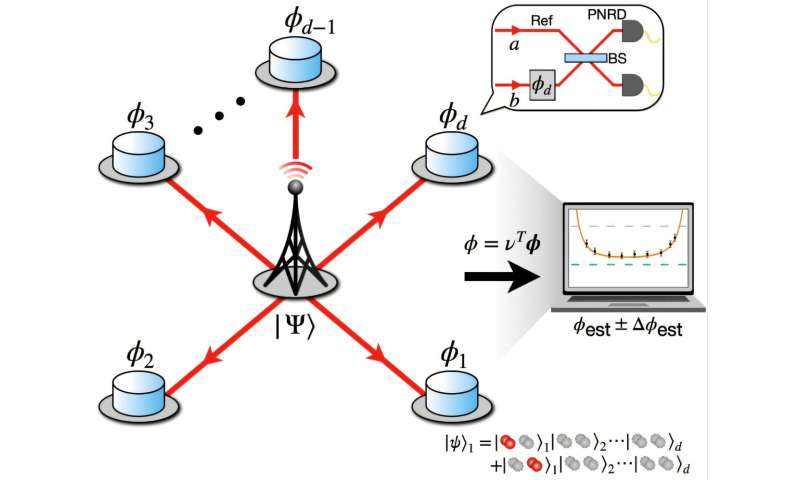Precise metrology forms a fundamental basis for advanced science and technology, including bioimaging, semiconductor defects diagnostics, and space telescope observations. However, the sensor technologies used in metrology have so far faced a physical barrier known as the standard quantum limit.
A promising alternative to surpass this limit is the distributed quantum sensor—a technology that links multiple spatially separated sensors into a single, large-scale quantum system, thereby enabling highly precise measurements. To date, efforts have primarily focused on enhancing precision, while the potential for extending this approach to high-resolution imaging has not yet been fully demonstrated.
Dr. Hyang-Tag Lim’s research team at the Center for Quantum Technology, Korea Institute of Science and Technology (KIST), has demonstrated the world’s first ultra-high-resolution distributed quantum sensor network. The study is published in the journal Physical Review Letters.
By applying a special quantum-entangled state, known as the multi-mode N00N state, to distributed sensors, the team achieved simultaneous enhancement of both precision and resolution.
Previous work on distributed quantum sensors has primarily relied on single-photon entangled states, which can enhance precision, but are limited to high-resolution measurements that require fine discrimination of interference patterns.
The multi-mode N00N state employed by the KIST researchers involves multiple photons entangled along specific paths, producing much denser interference fringes. As a result, the resolution is significantly enhanced, while even the smallest physical changes can be detected with high sensitivity.
The technique not only approaches the Heisenberg limit, the ultimate level of precision attainable with quantum technology, but also demonstrated potential for applications in super-resolution imaging.
This achievement is particularly significant, as it suggests that Korea can secure international competitiveness at a time when major advanced countries, including the United States and European nations, have designated quantum sensors as a next-generation strategic technology and are making substantial investments in the field.
-

Distribution of quantum states generated by a central node to each node, phase encoding at each node, and estimation of arbitrary linear combinations of phases through local measurements. Credit: Korea Institute of Science and Technology (KIST)
-

(a) Probability distribution as a function of phase value, (b) Fisher information as a function of phase value, and (c) average estimation result of two phases. Achieved 88% (2.74 dB) improvement in sensitivity over the classical limit, close to the Heisenberg limit. Credit: Korea Institute of Science and Technology (KIST)
The team created a two-photon multi-mode N00N state entangled across four path modes and used it to simultaneously measure two distinct phase parameters.
As a result, they achieved approximately 88% higher precision (2.74 dB improvement) compared to conventional methods, thereby demonstrating performance approaching the Heisenberg limit not only in theory but also in experiment.
The achievement has broad potential for applications across fields that require precision metrology, including life sciences, the semiconductor industry, precision medicine, and space observation.
For instance, it could enable high-clarity imaging of subcellular microstructures that are difficult to resolve with conventional microscopes, the detection of nanometer-scale defects in semiconductor circuits, and the precise observation of distant astronomical structures that would otherwise appear blurred through ordinary telescopes.
“This achievement marks an important milestone, demonstrating the potential of practical quantum sensor networks based on quantum entanglement technology,” said Dr. Hyang-Tag Lim of KIST.
“In the future, when combined with silicon-photonics-based quantum chip technology, it could be applied to a wide range of everyday applications.”
More information:
Dong-Hyun Kim et al, Distributed Quantum Sensing with Multimode N00N States, Physical Review Letters (2025). DOI: 10.1103/4vdx-7224. On arXiv: DOI: 10.48550/arxiv.2508.02070
Citation:
Distributed quantum sensor network achieves ultra-high resolution near Heisenberg limit (2025, October 27)
retrieved 28 October 2025
from
This document is subject to copyright. Apart from any fair dealing for the purpose of private study or research, no
part may be reproduced without the written permission. The content is provided for information purposes only.

